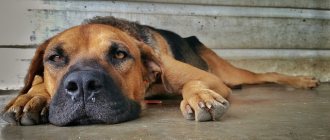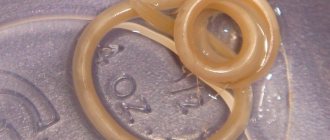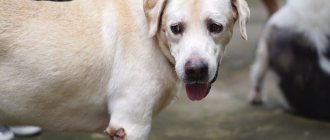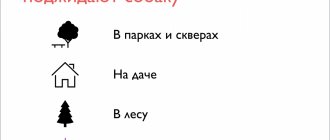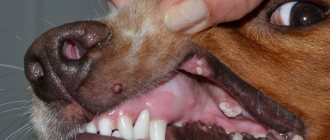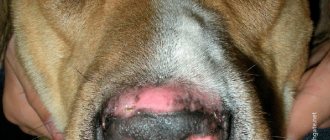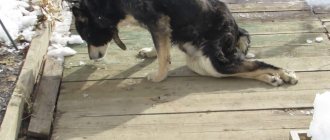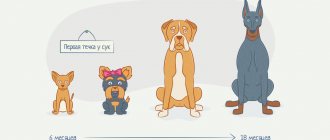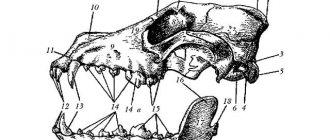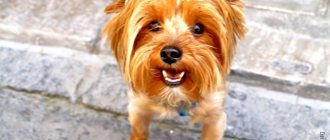Dogs, like people, quite often have problems with their teeth, and they are also familiar with toothache. The first sign of carious disease is demineralization of the enamel. This is the leaching of minerals from tooth enamel, as a result of which it darkens, loses its shine, acquires characteristic yellow spots, and begins to deteriorate. Demineralization leads to a deficiency of the following substances: calcium, potassium, phosphorus, magnesium fluorine and chlorine. They enrich the enamel, giving teeth strength and beauty.
In the wild, the loss of teeth for a dog means quick death, since it can no longer eat or protect itself. In home or enclosure conditions, dental disease does not lead to tragedy, but it also causes great suffering to the animal. The dog refuses to eat, worries, and whines. In addition, an infection localized in the oral cavity can cause serious pathologies of internal organs. The article will talk about the signs by which you can determine that your pet has a toothache. You will also learn about the treatment of caries in dogs and what to do to prevent its complications.
Classification of types of caries
Depending on the stage, there are four types of caries. This classification is valid for both medical and veterinary dentistry:
- Carious spot. A yellow spot appears on the enamel. This is the area of future damage to the tooth, although there are no signs of structural damage yet.
- Initial caries. The spot becomes darker. The enamel in the area of the carious spot softens and begins to collapse, but the deeper layers are not yet affected.
- Average caries. The destruction affects dentin, the main hard tissue underneath the tooth enamel.
- Deep caries. All tooth tissues are destroyed. There is no constant pain yet, but there is an acute reaction to various stimuli - temperature or taste.
If the disease is acute, the infection quickly spreads to healthy teeth.
According to the location of the lesion, caries in dogs is classified as follows:
- fissure caries - destruction of the grooves of the chewing surface of the tooth;
- approximal caries affects the interdental contact surface;
- Cervical caries destroys the lower part of the tooth.
Deep caries leads to the development of complications, the symptom of which is constant pain:
- Pulpitis. Progressive caries gradually covers the internal tissues, which involves the pulp (loose connective tissue in which the nerves and vessels feeding the tooth pass) into the process. After it is exposed, the tooth begins to hurt very much, bringing suffering to the dog.
- Periodontitis. The disease is an inflammation of the connective tissue that fixes the root in the alveolus. Painful mobility appears.
Caries in dogs and cats
Caries is a common term denoting damage to the hard tissues of the tooth (enamel and dentin), caused by the pathological influence of oral bacteria on the calcium they contain. This disease is very common in humans, but is quite rare in dogs and cats.
Do dogs and cats have tooth decay?
Yes, sometimes. Although very often owners mistake any changes in the color of the enamel for caries, statistics say that caries occurs in 5.25% of dogs, and these lesions are almost always bilateral, that is, identical on the right and left, as if in a mirror image, which is good visible in the photo.
In dogs and cats, caries is much less common, because their teeth are more adapted to tearing and biting, rather than grinding and grinding food, so they have a more cone-shaped shape, fewer fissures and pits where cariogenic bacteria are usually located. This is also due to a different nature of nutrition (lower carbohydrate content) and the pH of gastric juice (about 7.5 in animals, while in humans it is about 6.5), the presence of buffer acids in it, a lower level of amylase in saliva, which breaks down starches into carbohydrates, which, as we have already said, are a breeding ground for carious bacteria.
Why do dogs get tooth decay?
There are many factors that influence the development of caries in animals. These include:
- An uneven lumpy or rough surface of the tooth, which is an excellent place for bacteria to attach and live; Based on this, very often caries forms on the first upper molars between the cusps, as well as on the 4th upper premolar (fissure of the buccal surface) and on the lower first molar (between the mesial and central cusps);
- Presence of specific cariogenic bacteria;
- Poor hygiene – the presence of food residues on the teeth and gums of the animal.
How does it develop?
Bacteria on the surface of the tooth ferment carbohydrates, releasing acids that attack the enamel. Demineralization of enamel leads to the destruction of the tooth matrix and the enamel becomes soft. With further development, small damage to the enamel surface moves deeper, causing destruction of dentin and cavities becoming visually noticeable.
What to do?
There is usually a balance, an exchange of enamel minerals and saliva. Normally, small losses of minerals are quickly offset by minerals that are present in sufficient quantities in the saliva of our pets and we do not observe any damage. In the early stages (before the destruction of the protein matrix), the disease goes away on its own. If the matrix is already destroyed and there are visible cavities, treatment is necessary that will stop the process of destruction deep into the tooth and close the cavity - a filling.
If the cavity is so deep that the pulp chamber of the tooth is open, it is infected and there are signs of pulpitis on a dental radiograph, it is better to remove such a tooth.
Bilateral carious lesions on the upper molars of a cat
Stage of treatment - placing a photopolymer filling
At the VetMax clinic, by appointment, you can consult with a dentist, undergo a dental examination, x-ray, as well as dental treatment with photopolymer and other materials, and tooth extraction. Keep a close eye on your pets and their health, even in small things, because with their love they deserve it!
The material was prepared by veterinary dentist Maria Alexandrovna Sikorskaya.
The mechanism of caries occurrence
Dental caries in dogs is usually one of the signs of a general painful condition of the body. The trigger for the disease is the appearance of dental plaque, which contains a large number of pathogenic bacteria (mainly staphylococci). Plaque settles on the teeth, resulting in close contact between the microbial flora and enamel.
The chemical composition of saliva facilitates such contact. The minerals contained in saliva, interacting with dental plaque, increase its density. This formation is tightly fixed to the enamel and is called a dental plaque. The product of this interaction is lactic acid, which has a destructive effect on the enamel, demineralizing it.
The surface of the tooth suffers especially severely in the presence of microscopic damage to the enamel. In this case, its destruction occurs especially quickly.
Causes of the disease
The main causes of caries can be divided into two main types:
- Mechanical. Tooth decay occurs much more often in older dogs than in younger dogs. This occurs due to enamel defects - the entry point for infection. The most common causes of defects are: careless removal of tartar, gnawing on very hard bones and other objects.
- Chemical. This is a change in the chemical composition of saliva, as a result of which aggressive acids are formed in the oral cavity, which have a destructive effect on the enamel.
There are a number of provoking factors, the presence of which accelerates the onset of the disease:
- Hereditary pathologies in the development of teeth and skull bones (malocclusion).
- Features of the breed. Representatives of small breeds are more likely to have similar problems.
- Deficiency in the diet of minerals necessary for dental health (calcium, potassium, fluorine, phosphorus, chlorine). This is especially dangerous in childhood, during the formation of dental tissue.
- Decreased general and local immunity as a result of past infections.
- Diseases of the gastrointestinal tract, rickets, metabolic disorders.
- Degenerative changes in old age. This is especially true for the composition and quality of enamel.
- Living in an area with poor environmental conditions.
- The presence of sweet foods in the diet, which is the main cause of disruption of the acid-base balance of saliva.
Consequences of untreated caries
As a result of long-term and untreated caries, a pet may develop pulpitis, that is, inflammation of the internal tissues of the tooth. This occurs due to the exposure of the pulp due to abrasion of the crown of the tooth. Pulpitis is divided into chronic and acute, purulent and aseptic, granulomatous and gangrenous. Teeth affected by pulpitis must be removed.
Also, untreated caries, together with tooth trauma, can cause periodontitis, that is, inflammation of the periodontium, the connective membrane that connects the jaw tissue to the tooth root.
In modern veterinary clinics, dogs can have their teeth filled. If the clinic has an X-ray machine, the dog will have a dental image taken to select the correct treatment method. Tooth filling is performed under general anesthesia so that the dog does not interfere with the treatment process. At the first stage, the caries cavity is prepared, followed by the installation of a therapeutic-isolating lining. At the last stage, a multilayer filling of the tooth cavity occurs, for which cement or other composite materials are used.
As a rule, if the caries is too deep, the animal’s tooth will simply be removed under general anesthesia. If a dog has had a tooth removed, then for several days after this the dog should eat liquid food: broths, fermented milk products.
When the carious process has not gone too far, and the clinic does not have modern equipment, the veterinarian will simply clean off the affected layer, and in order to prevent the putrefactive process from developing further, the tooth will be treated with silver nitrate. In order to know exactly how deep the caries has gone, special solutions are used that are applied to the tooth and stain only the affected areas of the enamel.
Further treatment involves switching the animal to soft food, eliminating dry food altogether, the dog’s oral cavity is regularly treated with disinfectant solutions, and an iodine-glycerin solution is applied to the gums.
Potassium permanganate, chlorhexidine, rotokan, and calendula tincture can be used as disinfectant solutions.
Symptoms of the disease
In dogs, caries is determined by the following characteristic signs:
- unpleasant odor from the mouth;
- dark spots on the enamel or cavities filled with food particles;
- increased salivation;
- refusal of hard foods;
- hyperemic gum tissues, pain when pressed;
- with deep caries complicated by periodontitis, loose teeth can be noticed.
Diagnosis and treatment of the disease
Diagnosis and treatment of caries is possible only in specialized veterinary clinics equipped with dental equipment.
X-ray examination is most often used for diagnosis. It is also possible to use special chemical compounds that stain tooth tissue. Their application allows you to determine the depth of tissue damage.
In case of superficial or moderate caries, the pet’s teeth are not filled, but the carious cavity is disinfected and treated with a solution of silver nitrate. This helps stop the destruction process. At home, antiseptic solutions are used - Chlorhexidine, Rotokan, Metrogyl Denta, which kill pathogenic flora in the mouth.
A tooth affected by deep caries is filled with cement or special plastics.
If the destruction has gone very deep and there are signs of complications, then the diseased tooth must be removed to prevent the remaining teeth from being involved in the inflammatory process.
Disease prevention
Prevention of caries in dogs consists of eliminating factors that provoke the disease. There are also certain precautions by which the disease can be prevented, namely:
- use only high-quality feed, exclude sweet foods from the diet;
- ensure that the diet contains a sufficient amount of minerals that affect the quality of enamel;
- periodically carry out oral hygiene - brushing teeth, removing tartar, treating with antiseptic drugs;
- Promote natural teeth cleaning by purchasing special hard chewing toys for your dogs. It is allowed to give non-tubular raw bones for chewing;
- It is advisable to periodically take your pets to the veterinarian for an examination of the oral cavity.
Dental health is an essential part of keeping your dog fit. All systems of the body are interconnected, so disruption of the functioning of any organ immediately negatively affects the activities of the rest.
Video. Dog dentistry. Clinical cases, treatment options
Caries in dogs.
Among all diseases of dogs, caries is far from the last place. It is the destruction of hard dental tissue, which leads first to the formation of cavities in the crown, and then to more serious consequences - damage to the pulp and root of the tooth. If this disease progresses further and spreads to neighboring teeth, periodontal disease begins. Ultimately, the process can go far and the dog will lose some of its teeth.
To prevent this from happening, you need to know how caries manifests itself, clearly understand the causes of its occurrence, know and apply preventive measures, and in case of urgent need, seek veterinary help.

